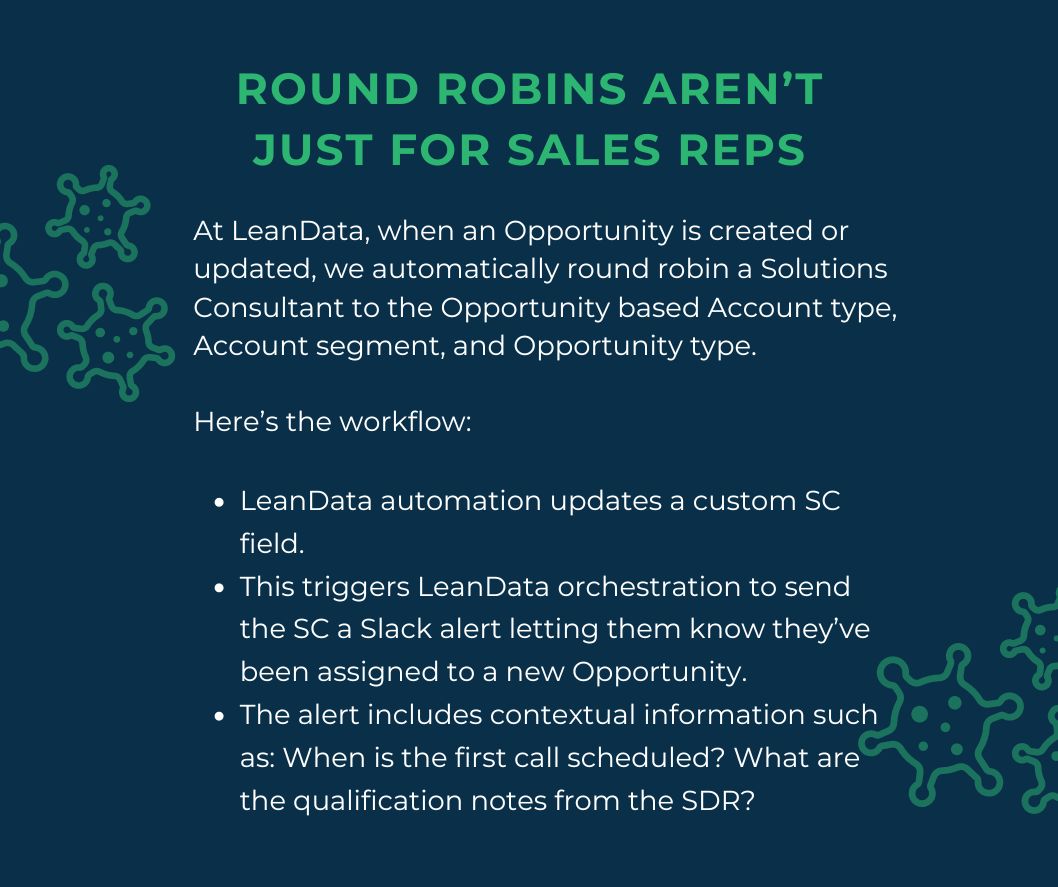If you need a way to distribute leads to your sales team that’s fair, FAST, and improves the B2B buying experience… look no further.
Round robin lead distribution is your new best friend.
Lead distribution strategies optimize sales team productivity and revenue growth. One such strategy is round robin lead distribution. This sales lead rotation system ensures a fair and equal distribution of leads among sales reps.
More importantly, a round robin lead distribution strategy is one of the most common ways companies boost speed to lead.
What is a Round Robin?
A round robin is a type of lead distribution strategy.
While most lead strategies allocate leads to individual sales reps, round robins are slightly different. They assign leads by rotating through a pool of sales reps in a cyclical manner.
The end goal? Equal and even distribution of leads.
This method ensures every rep has an equitable opportunity to sell to potential customers.
How Do Round Robins Impact Productivity?
Lead response times
Automated lead distribution has a positive correlation on lead response time. For round robins, this is a result of its cyclical nature.
This cycle gives sales reps an idea of when they might receive leads. As a result, communication starts immediately, reducing contact delays, and maximizing lead response time.
This alludes to round robins having a bigger role in effective lead management than one might think. After all, their role in optimizing speed to lead through lead routing systems is what sets the stage for a successful go-to-market motion.

Equal distribution
Equal lead distribution systems such as round robins evaluate important factors before they start distributing leads. They review each sales rep’s current workload and schedule.
For example, if a sales rep is working at capacity, they won’t be assigned any more leads. By ensuring each rep receives an equal number of leads, round robins prevent any single rep from being overwhelmed or underutilized.
Instead, remaining leads will be evenly distributed among other sales reps on the same team, starting with those who have the least amount of work on their plate. On top of that, round robins account for time off. This ensures the entire team faces an even workload that aligns with their individual schedules.
By upholding equal and balanced lead allocation, round robins prevent situations where some sales reps have more work than others. This helps cultivate a strong and productive team through maintaining a sense of fairness and encouragement.
Minimize Conflicts
Round robin distribution minimizes conflicts over lead ownership, as the system is transparent and fair. This reduces time spent on disputes and allows reps to focus more on their sales activities, thereby improving productivity
Do Sales Reps Like Round Robins?
Perceived fairness and effectiveness in lead distribution
Sales reps appreciate round robins for the fairness they bring to a team. After all, they ensure every sales rep has an opportunity to work with prospects and leads.
Round robins also provide a sense of security for teams. They eliminate concerns over potential favoritism or being over/ underworked. As a result, this motivates reps and gives them the confidence to do well and perform at their best.
Impact on team morale and motivation
Round robins have a huge impact on team morale and motivation.
When an organization distributes leads fairly and equally via round robin, sales teams are more engaged and motivated to perform well. As a result, it facilitates a working environment that is both collaborative and supportive, while encouraging teamwork among sales reps throughout the entire sales cycle.

How to Implement a Round Robin Strategy in your CRM
Technical requirements
In order to successfully implement a round robin, you first need to confirm that it will be technically supported by your CRM. Round robins are a native feature to some CRMs, whereas others may need additional tools and/or integrations.
A 7-step round robin implementation plan
1. Define the Objectives and Criteria
Your primary objective is the equal distribution of leads, maximizing team efficiency, and improving response times. Establish criteria by determining exactly what qualifies a lead for round robin distribution: geographic location, lead score, product interest, or something else.
2. Choose the Right Tools
Use a CRM that supports automated lead distribution like Salesforce or Hubspot. Consider adding lead routing software if your CRM doesn’t offer robust round robin features.
3. Set Up the Round Robin Logic
Configure your CRM or lead routing tool to distribute leads evenly. This can typically be done by setting up a round robin lead assignment rule. Ensure all sales team members are added to the round robin pool and are assigned equally. Also consider the strengths of your sales team members. Newer sales reps may need time to ramp so adjust accordingly.
4. Integrate Lead Sources
Ensure all lead capture forms on your website, landing pages, and social media are integrated with your CRM. Set up processes for importing leads from external sources like trade shows, webinars, purchased lists, etc. into your CRM.
5. Test the Process
Run a pilot test with a small batch of leads to ensure the distribution is working as expected. Make necessary adjustments based on feedback and initial results.
6. Monitor and Optimize
Create dashboards and reports to monitor the lead distribution, response times, and conversion rates. Collect feedback from the sales team to identify any issues or areas for improvement. Regularly review the process and make adjustments to optimize performance.
7. Sales Enablement and Training
Train the sales team on how the round robin process works and how to manage leads in the CRM.
What Kinds of Customizations Are Available with Round Robins?
At LeanData, round robins are a key feature of our industry-leading Salesforce-native routing solution. LeanData has the ability to create round robin pools to distribute Leads, Contacts, Accounts, Opportunities, or Cases to a group of users or queues.

Accounting for sales rep ability levels
There are some lead distribution tools that allow “skill level” to be used as a criteria for assigning leads. This means that the round robin will operate cyclically as usual, but with this extra information in mind. As a result, leads will be received by the most skilled and qualified reps needed to engage with them.
Pause when people are on leave or reach capacity
If you’re wondering what happens when a sales rep is out of office, don’t worry– there’s a way to account for that.
First, round robin solutions typically include customization options that essentially presses “pause” on any sales rep in the pool. When reps are paused, they’re removed from the pool until they’re back in office.
However, even when certain reps are removed/ paused, the round robin keeps operating as usual. This ensures that leads are still evenly distributed amongst reps even if someone is absent.

Incorporating business rules/territories and segments into round robins
Every company has rules, territories, and segments that reflect their business and operational strategies. Round robins can be customized around these factors, which ensures that lead distribution stays aligned with revenue processes.
What’s the Best Way to Scale a Round Robin Strategy?
Scaling a B2B round robin lead distribution strategy effectively requires a mix of technological tools, clear processes, and continuous optimization.
What happens as your sales team and lead volume grows?
At the end of the day, it’s important to check in on your round robin strategy every once in a while in order to monitor its effectiveness. This is especially true as sales teams and lead volumes grow.
Depending on your changes, there are things you can edit within the round robin itself. For example, consider reorganizing round robin pools, or re-evaluating sales reps. Based on what you find, you can adapt the structure and/or customizations of your round robin strategy to accommodate for the changing workload.
How easy is it to adapt to changes in sales processes or market conditions?
Overall, round robins are quite flexible. They can be adapted to account for most changes in sales processes and market conditions.
However, the CRM is where all of these adaptations are made. Double check that your CRM allows for round robin rules and configurations to be edited and/ or reconfigured.

What Metrics Should You Track With Round Robins?
There are four primarily metrics that help track the effectiveness of your round robin strategy:
- Lead Response Time
- Lead Conversion Rate
- Lead Distribution Fairness
- Lead Abandonment Rate
Tracking these metrics helps in continuously improving the round robin lead distribution process, ensuring fairness, optimizing sales performance, and ultimately driving higher revenue.









